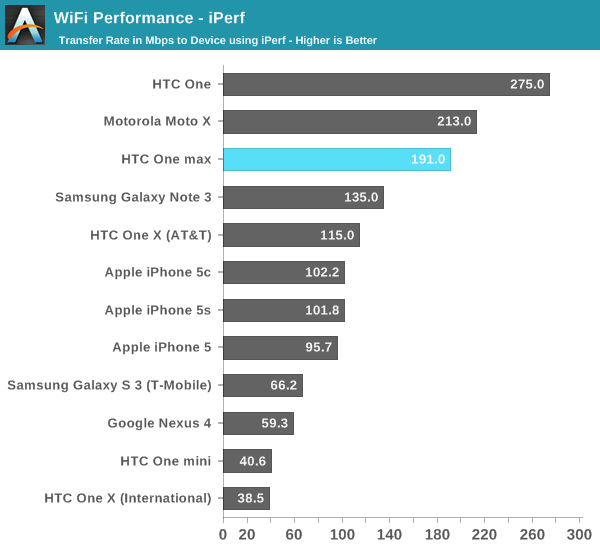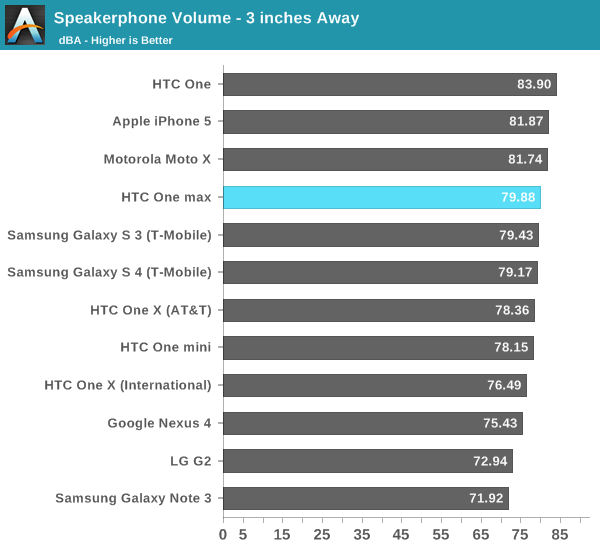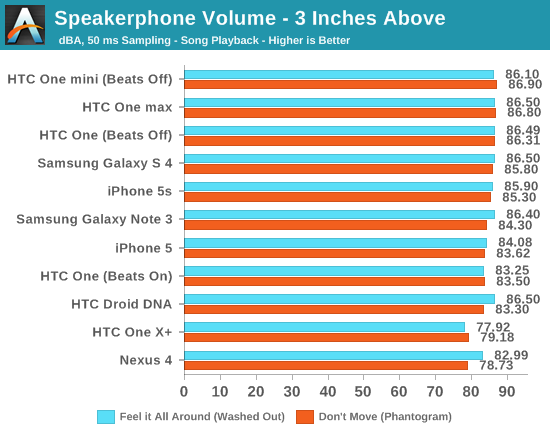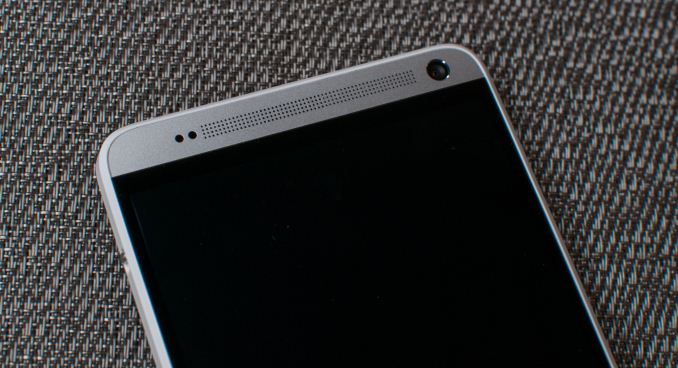HTC One max Review - It's Huge
by Brian Klug on October 28, 2013 10:00 AM EST- Posted in
- Smartphones
- HTC
- Mobile
- One
- Snapdragon 600
- Android 4.3
- One max
Cellular
Cellular on the One max is pretty much the same story as the One, and another shared bullet point. The top and bottom metal cutouts are still the radiative surfaces of the antenna, and there’s still transmit and receive diversity as well to mitigate any unwarranted antenna detuning from holding the device. The unit I was sampled has LTE banding for EMEA (Europe, Middle East, and Africa), but there’s appropriate banding for Asia, Sprint (a tri-mode device with 800/1900 MHz and TDD-LTE on 2600 MHz) and Verizon (700 MHz and AWS), according to the HTC specs page.
The baseband inside the One max is again shared with the One (Qualcomm’s 2nd generation multimode LTE MDM9x15 family), although the One max does have a bit more band support for the USA LTE on Sprint and Verizon, so the front ends are different.
WiFi
Interestingly enough with the One max we see HTC going to Qualcomm Atheros for the WLAN and BT combo, best I can tell this is the WCN3680 which is probably a bit cheaper to include than the BCM4335 we saw in the One. It’s still a single spatial stream 802.11ac capable part, meaning a PHY rate of up to 433 Mbps if you’re in the right channel conditions with 80 MHz channels on 5 GHz. The WCN3680 combo is the 802.11ac successor to WCN3660 which we saw in a number of phones last generation, and is accelerated by the SoC. WCN3680 also does BT 4.0, and FM Rx/Tx if applicable.

To test throughput on the One max I used iPerf the same way I have for a while now. Subjectively there are no complaints from me about WLAN connectivity on the One max, no random dropouts or issues, and Sense 5.5 thankfully still includes the WiFi frequency band manual selection option.
I saw the WCN3680 solution inside Moto X already, it’s interesting to see it in the One max. I believe the One mini uses its 802.11n cousin, WCN3660 as well, probably again for cost reasons.
Speakerphone
Although Beats is gone since that partnership has ended as of the One max, the device still seems to retain everything that made it sound great. There are still the larger-than-typical speaker chambers, big speaker grilles on the top and bottom, stereo sound, and importantly the TFA9887 speaker amplifier and protection part from NXP. In addition there’s still the TPA6185 headphone amplifier as well.
Beats always seemed to be an audio compressor that ran on the DSP, ostensibly through the Hexagon DSP access program or something, and that’s what’s absent on the One max. There’s no toggle under settings for enabling or disabling it, nor the Beats branding, but to be honest I almost always disabled Beats on the One anyways since it was a fair amount louder with it disabled. What made the One great was all the hardware behind the speakers, not so much the software compressor.


The One max goes plenty loud just like the original One. I went ahead and added the One mini and 5s to the chart too, just to check whether things have changed much, in addition to the Galaxy S 4 and Note 3. The One max basically performs like the One with Beats turned off, which isn’t a surprise since it isn’t there anymore. There’s also no detectable saturation, and the One line remains the only device that doesn’t sound tinny or rattly with overemphasized highs and lacking mids. I suspect the A weighting I selected a while ago for measuring might be a contributing factor as well. Either way you’re not going to be wanting for more loudness on the One max, and the inclusion of front firing stereo speakers makes for a completely different listening experience.












197 Comments
View All Comments
Tegeril - Friday, November 1, 2013 - link
I love the way that his opinion (that's a component of reviews) that build quality suffers when SD cards are involved (particularly in the context of *this* device) is not valid but yours is?Spunjji - Thursday, November 28, 2013 - link
The point is that neither is more valid, but Brian's claiming his is. Ta-daaa!bairlangga - Monday, October 28, 2013 - link
Dear Brian,Other manufacturer had the solution towards the door and build quality tradeoffs, it is called sd card slot with flap. Pretty please do a review on Xperias line.
chizow - Monday, October 28, 2013 - link
I've read most of them and still find them off-base. Your arguments about a small demographic are based on what? The entire smartphone market? Honestly, this means about as much as Nokia claiming they held the majority of the cell phone market up until a few years ago, it means very little out of context. It's all about what part of the market you are targeting, for flagship phones and high-end power users, features like microSD and changeable batteries make all the difference that can be a deciding factor in which phone to purchase.Similarly, people who care about aluminum unibody construction are a vast minority, imo, when all I see are people obscuring these case materials in protective cases made of polycarbonate or rubber.
In any case, it is good to see phone makers like HTC One are not taking your opinion as gospel, and instead, listening to their customers in deciding their hardware approaches. It is clear to me that HTC saw how the One was losing to the S4, despite positive reviews declaring the One superior in many categories only to lose in sales due to features like microSD, removable battery, 802.11AC. Coincidentally, I just named the 3 big reasons I bought an S4 instead of the One a few months ago. I fully expect the next iteration to follow the One Max and offer a microSD and removable battery, but we shall see.
rituraj - Wednesday, October 30, 2013 - link
May be HTC were stupid that they had to open the entire phone's back to put that microsd card. What about a slot from the sides. I believe a phone this big has quite a long side. I guess quantum geometry supports me. But yeah, that 1cm slot will destroy the build quality too just like the sim card does.Samwise - Monday, October 28, 2013 - link
Anandtech, please include the Droid MAXX in you battery life comparisons. Thank you.tuxRoller - Monday, October 28, 2013 - link
Why don't you have the iDevices storage benched?VengenceIsMineX - Monday, October 28, 2013 - link
Pretty disappointing product really. No OIS, lesser SOC, and nothing really innovative or even a great price. I'm in the market to optimize down to 1 device from a phone & small tablet to just a phablet but I don't think I'll bother considering the HTC compared to either the Sony or the Lumia 1520.sherlockwing - Monday, October 28, 2013 - link
The lack of S800 and OIS are very disappointing, to add the SD slot but not the S800 SOC to enable UHS-I speed for SD card is pretty silly.mregan - Monday, October 28, 2013 - link
Brian,Did you notice the problem that Zoes included in a highlight video now only show 1 second of motion and then freeze? I've seen that on my One when I upgraded to 4.3 and others have reported the same issue. It really seems like a bug. The highlights become much more static. All the other highlight changes are great but this is a step backward.
Mike R